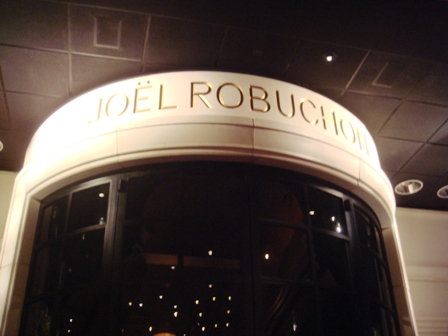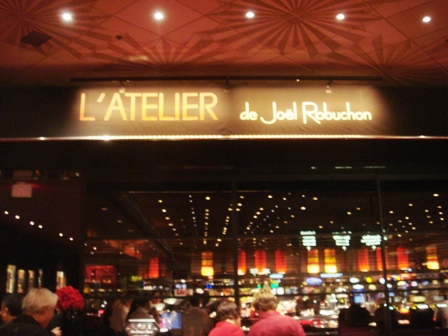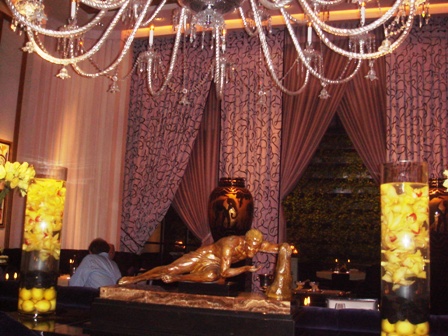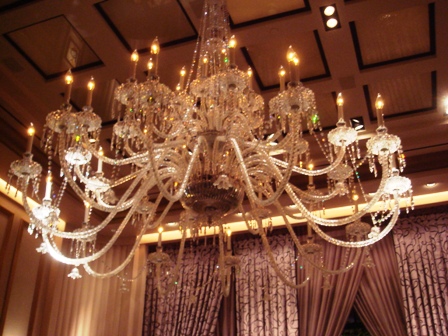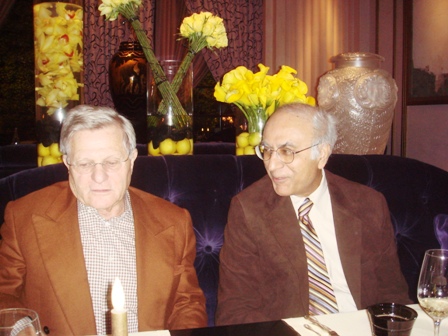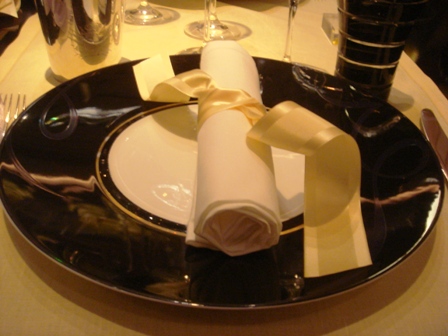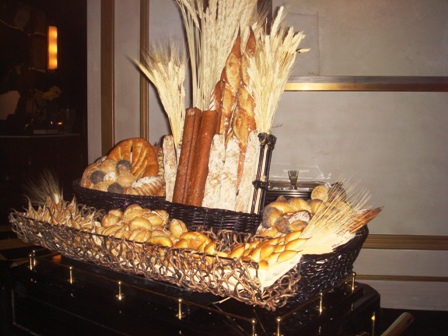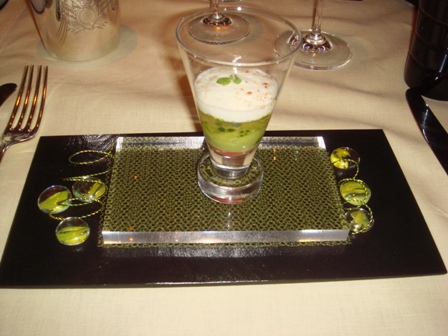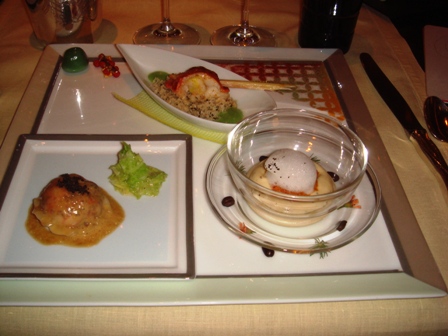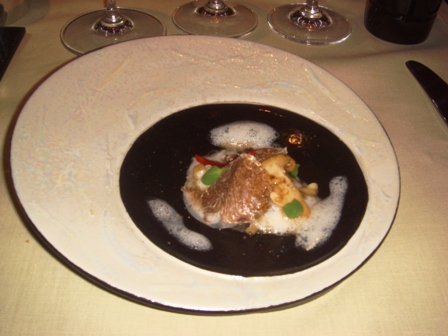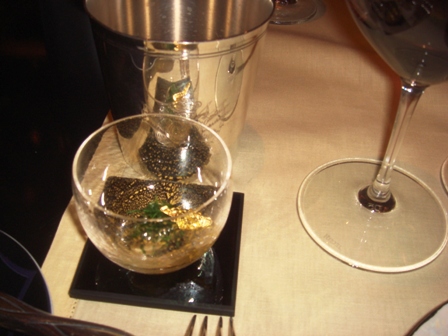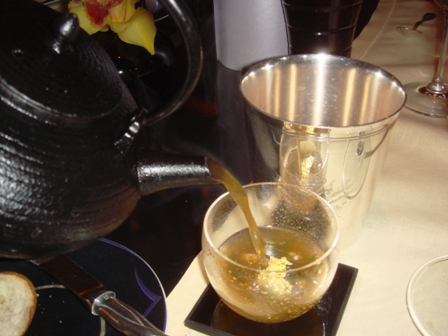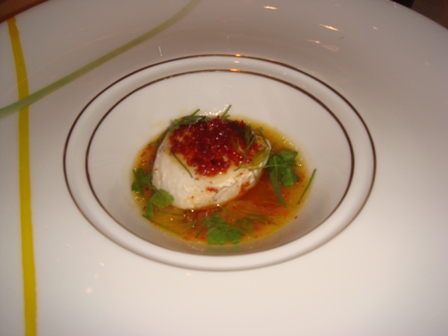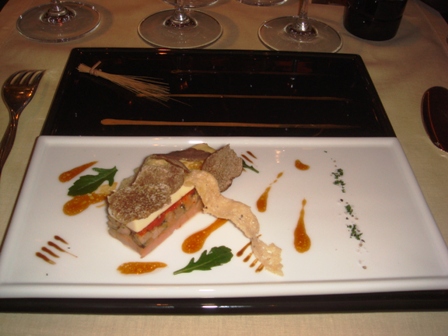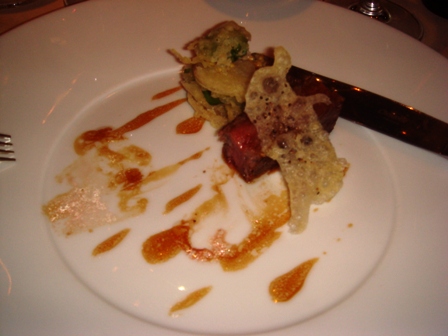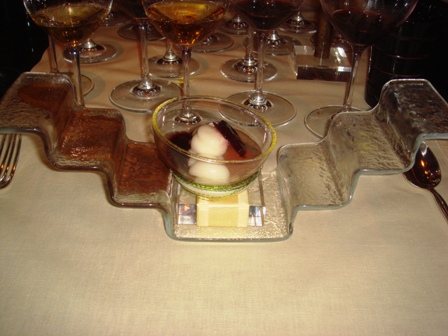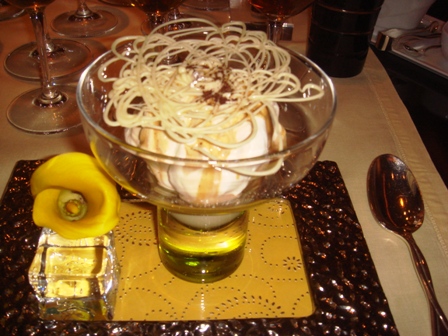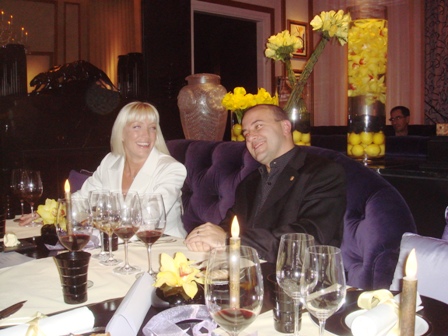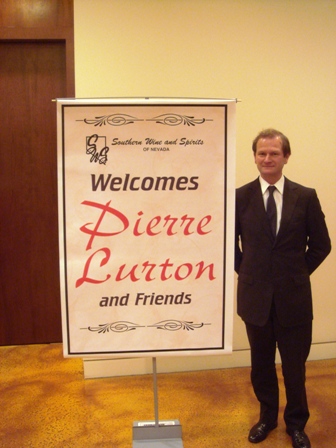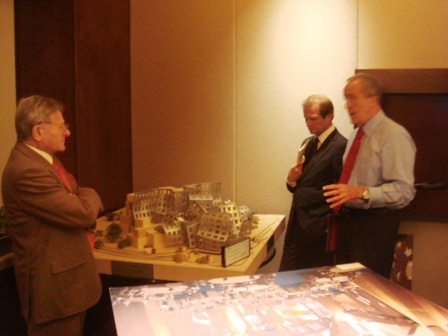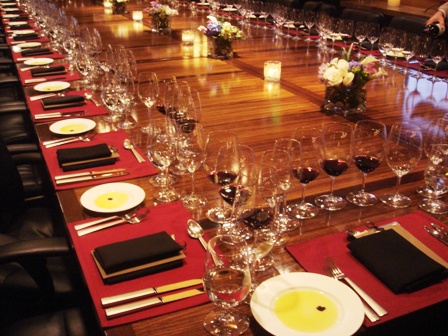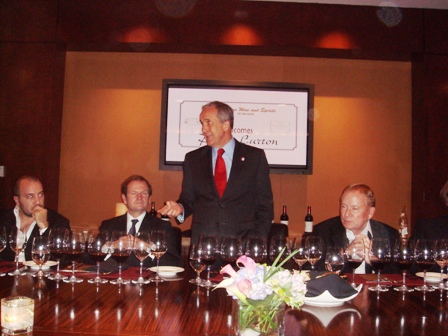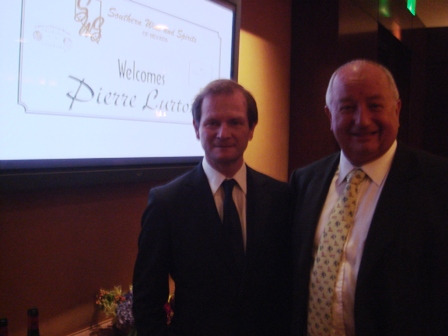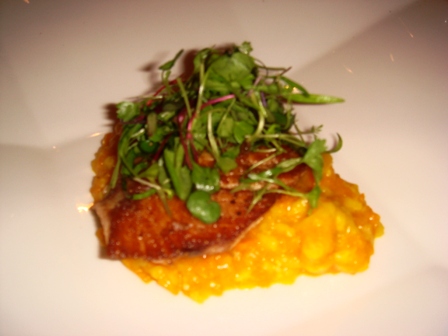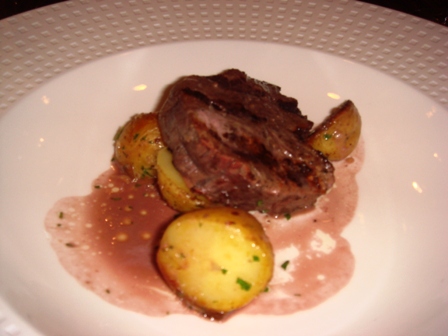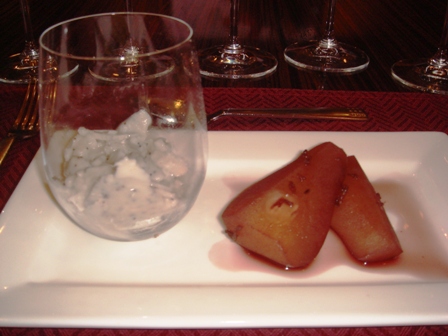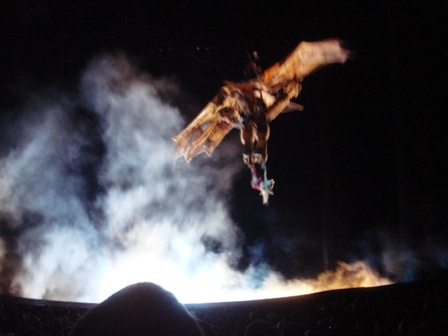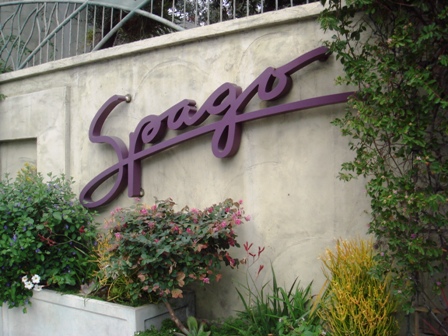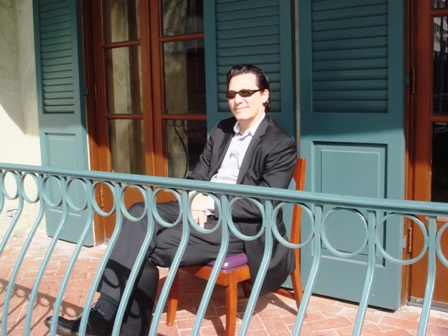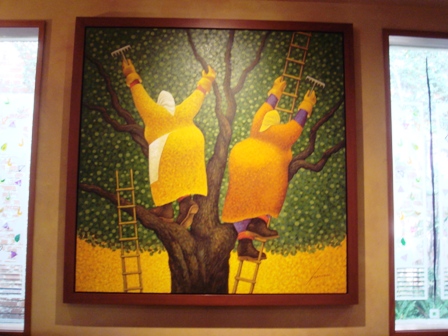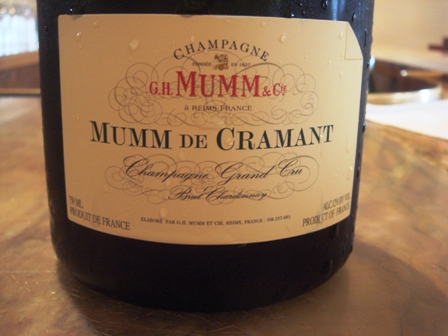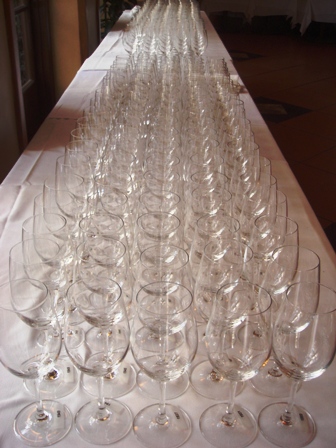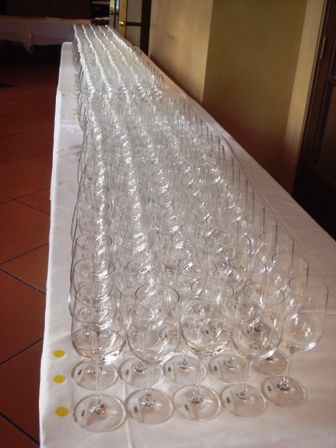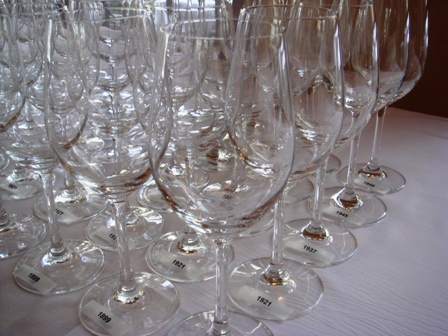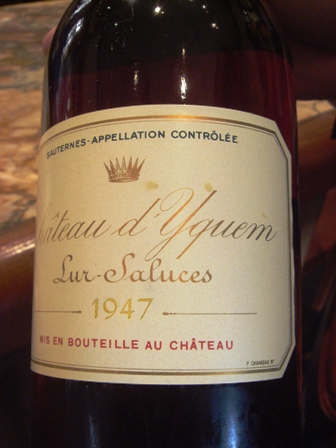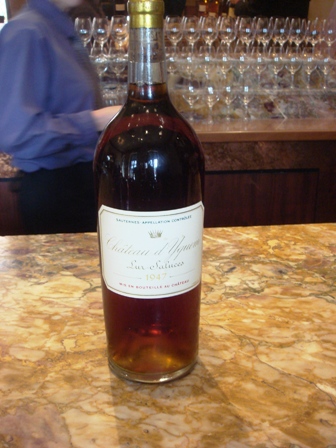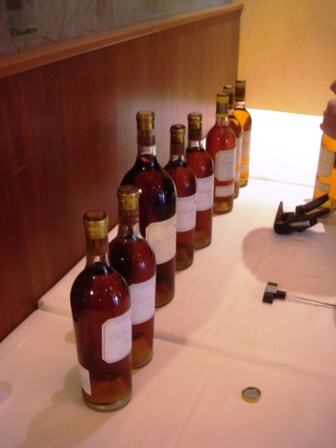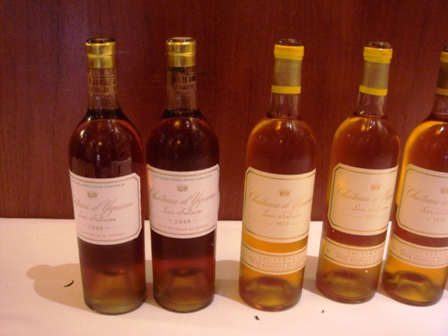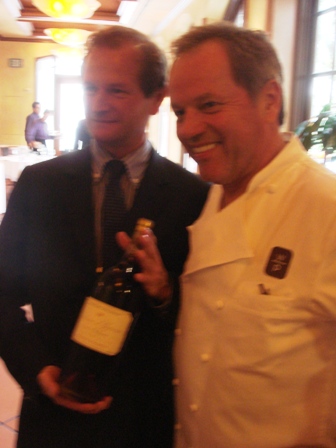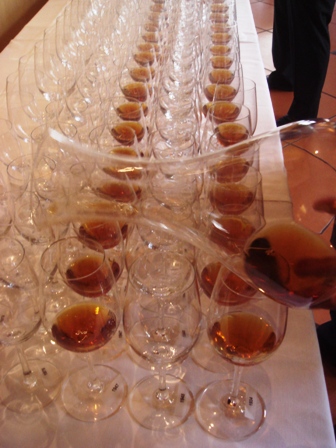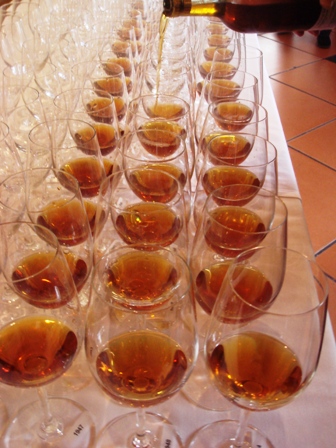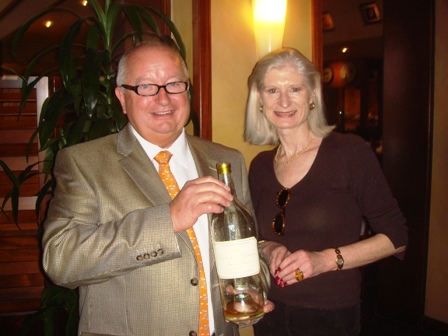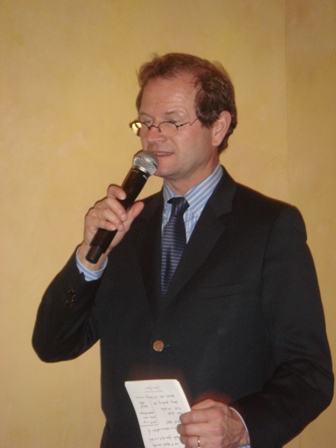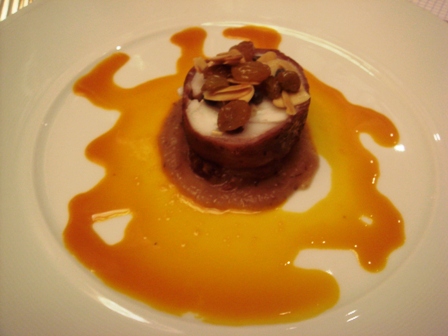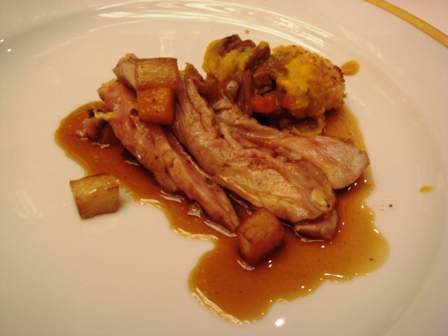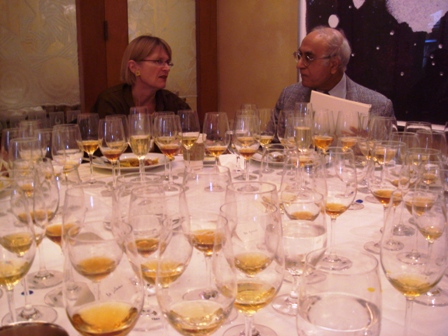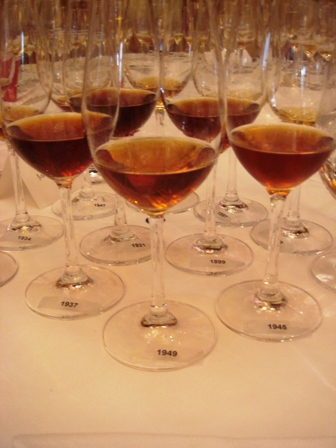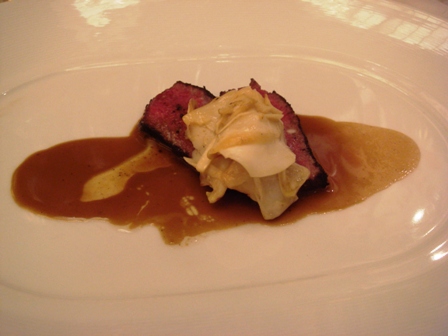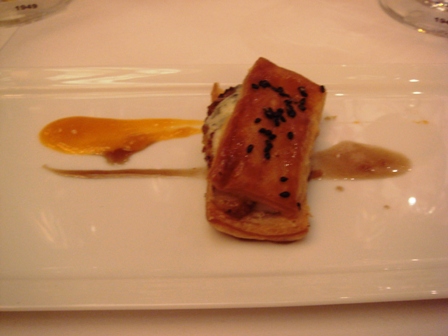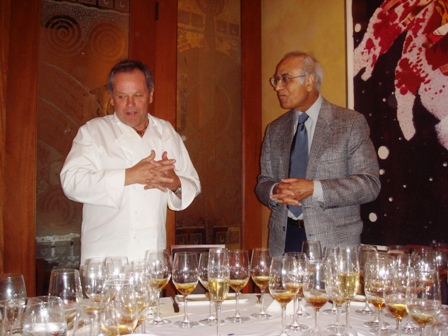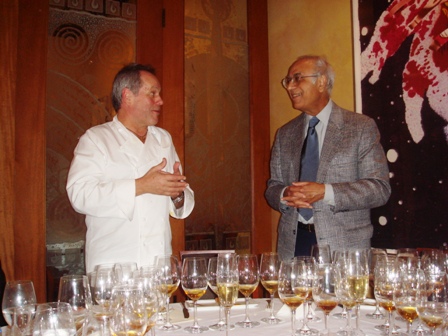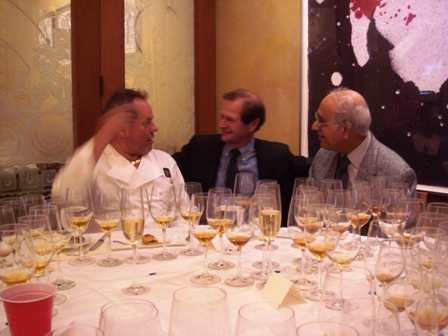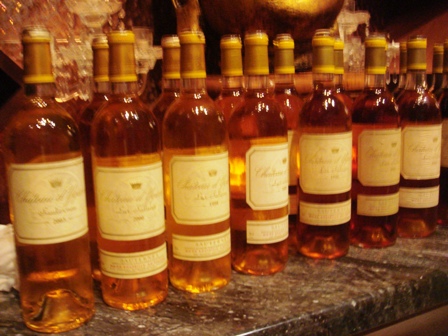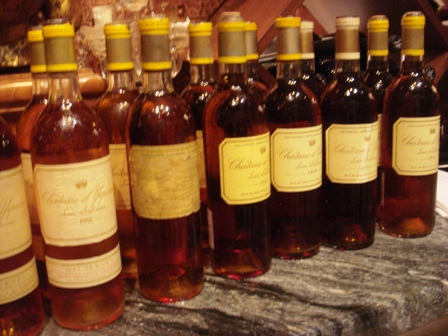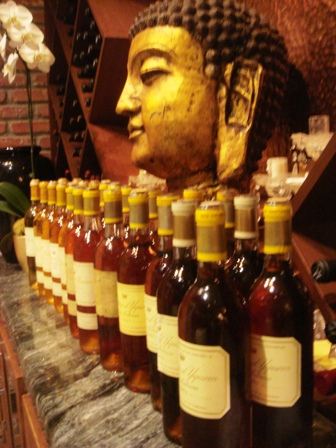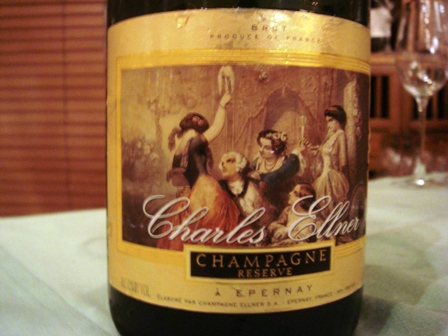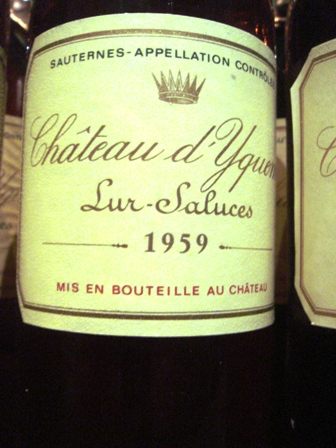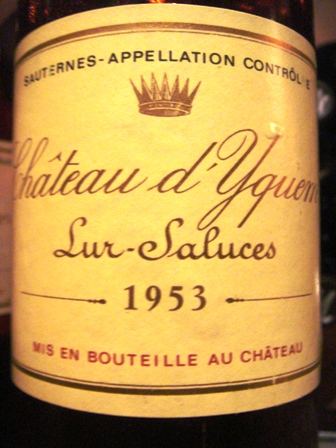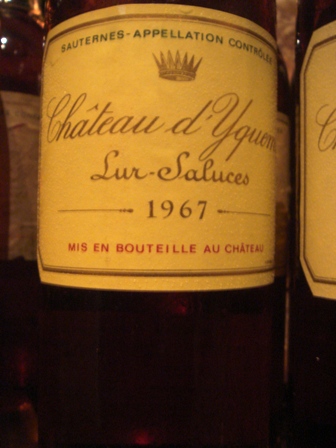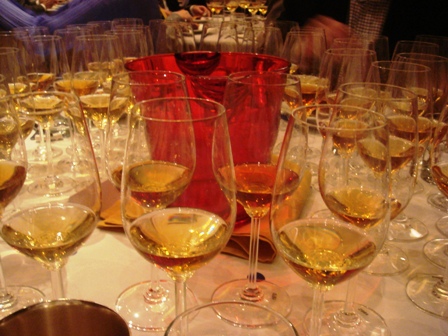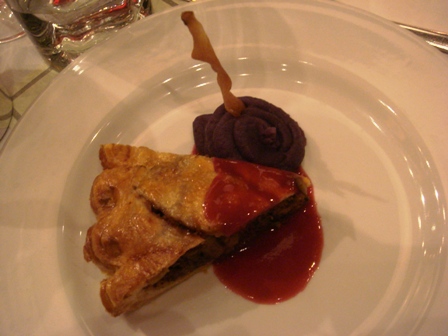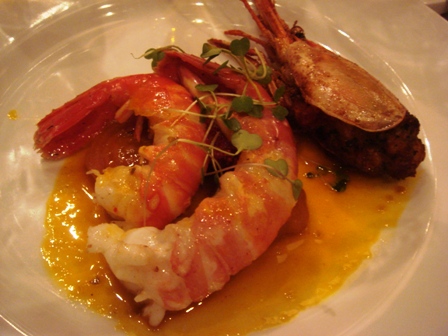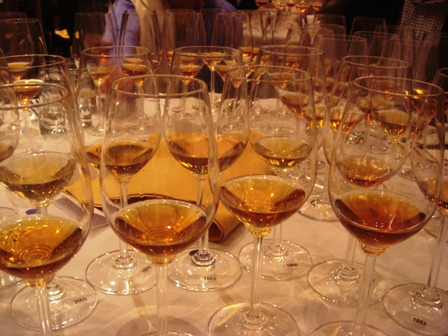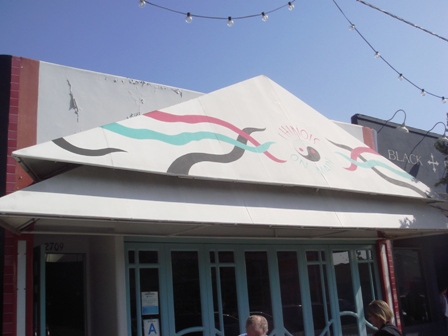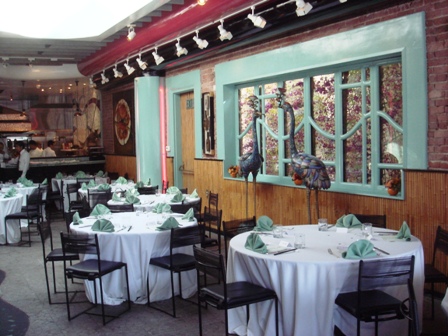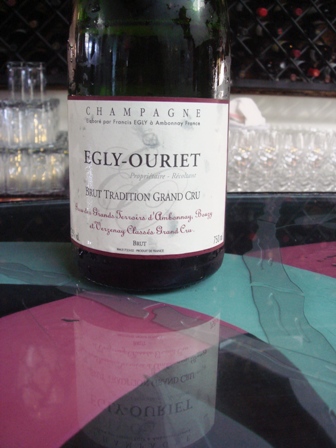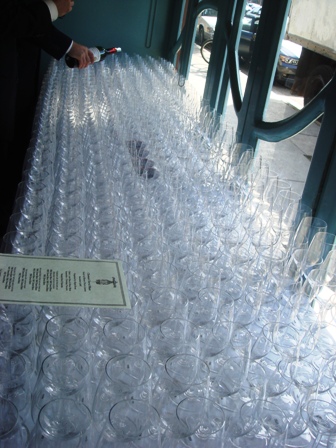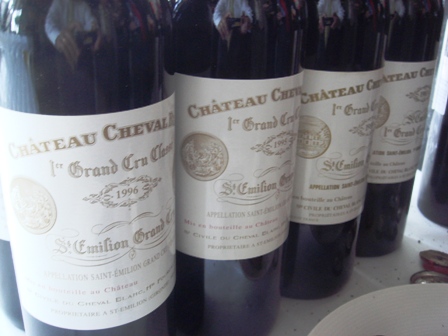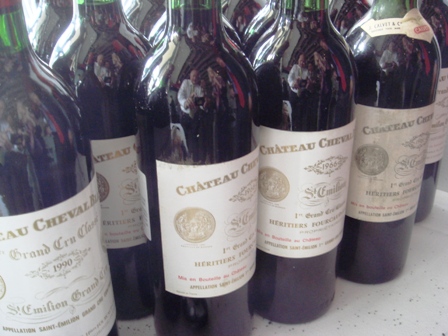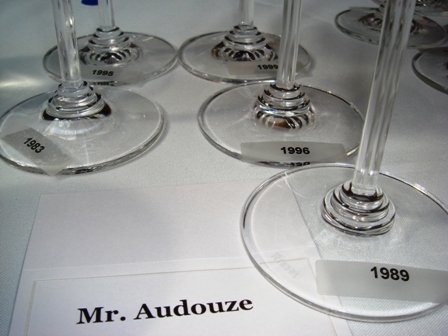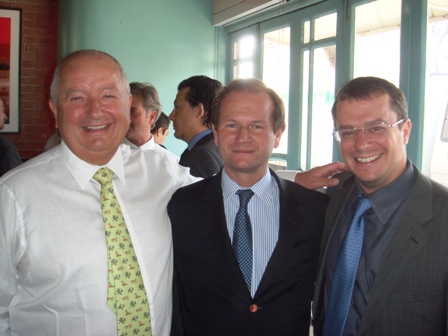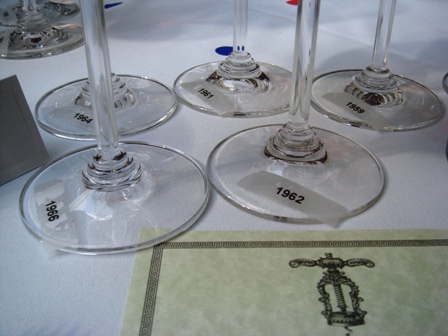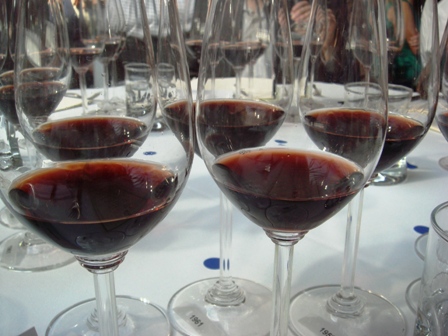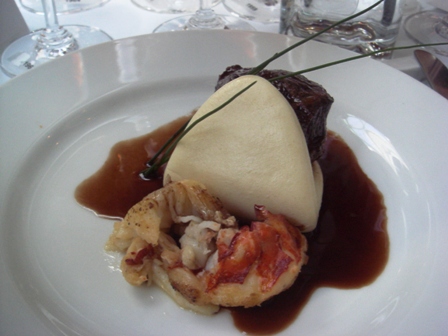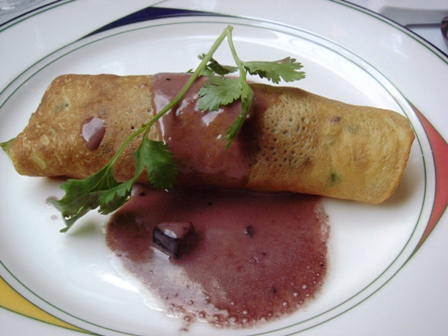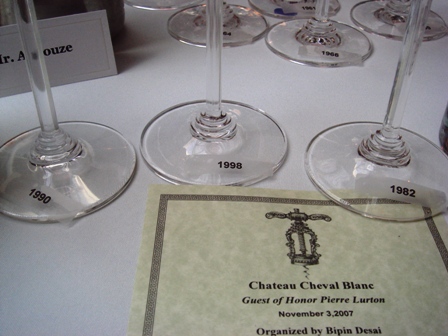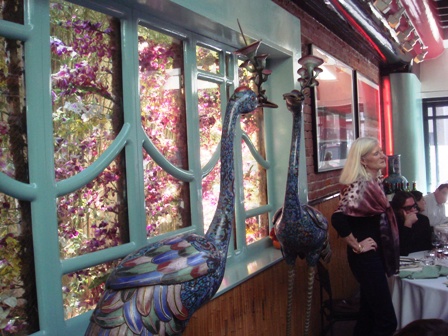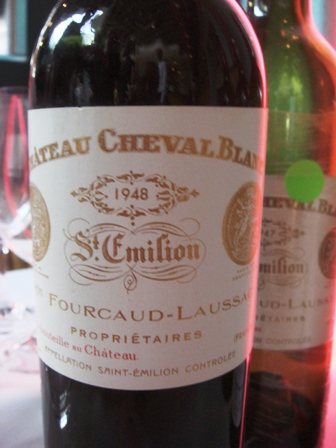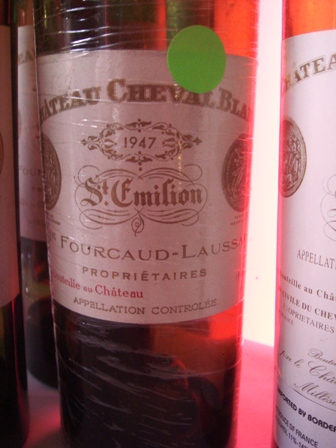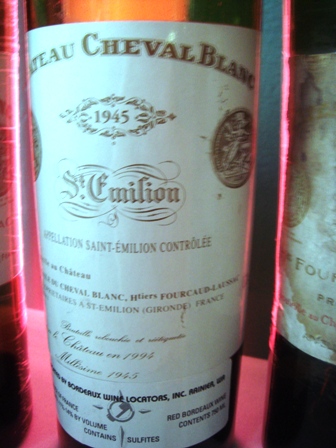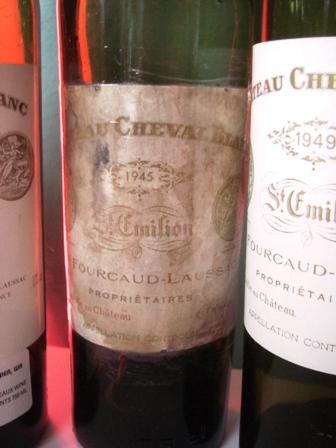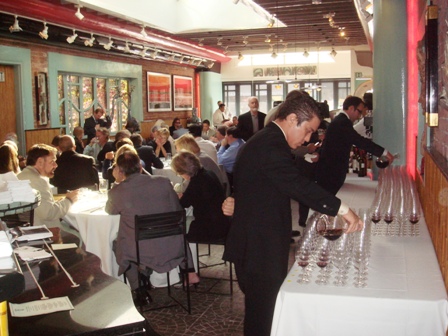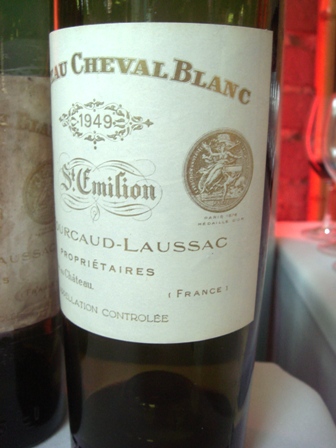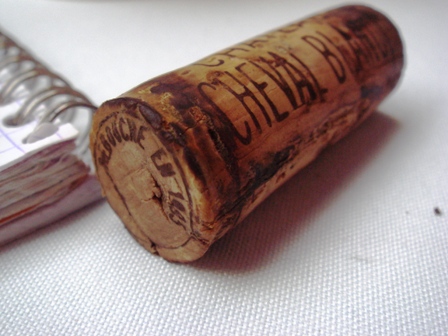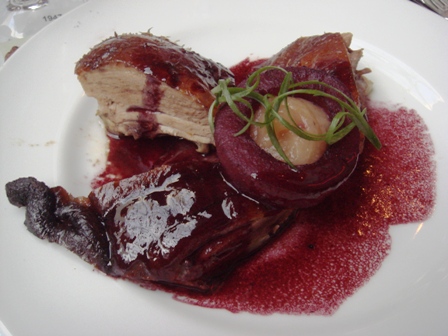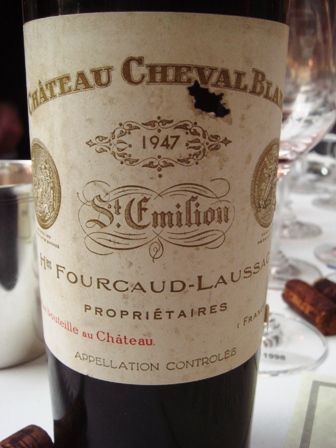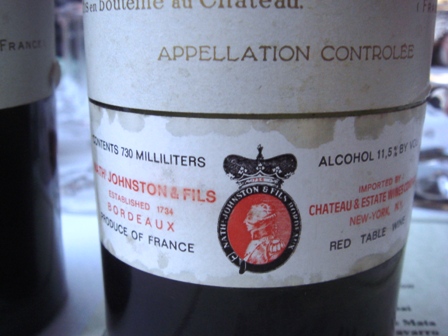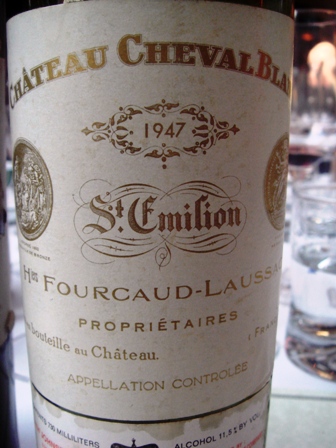Après un petit break suivant le déjeuner avec les plus grands Cheval Blanc, nous nous retrouvons à nouveau pour le premier repas consacré à Yquem, un dîner à Chinois on Main, avec la cuisine de Luis Diaz et René Mata, et avec la supervision des vins de Christian Navarro. La dégustation est conduite par Bipin Desai et l’invité d’honneur est Pierre Lurton, qui va nous donner des informations très précises sur chaque année avec les dates de vendanges, les rendements, les taux d’alcool, d’acidité et de sucre potentiel ou résiduel. Je suis arrivé très en avance de mon hôtel, aussi je peux voir toutes les bouteilles dorées alignées sous la bienveillante protection d’un Bouddha, dont l’énigmatique visage semble indiquer qu’une telle offrande est acceptable par Lui.
Le menu se compose de : passed hors d’oeuvre / Pithivier of stir-fried squab with roasted sweet potato puree / Santa Barbara prawns on sweet and sour beets with sesame seed and plum wine emulsion / roasted Kurobota pork loin with slow braised shoulder, dry apricots and toasted almond / upside down passion fruit cheesecake with pineapple sabayon.
Si l’on excepte le porc, je n’ai pas été impressionné par les essais d’accords avec Yquem, qui peuvent être largement meilleurs comme nous le verrons demain. Mais l’endroit est si charmant et le staff est si actif que nous avons passé un très beau moment.
Voici une anecdote qui m’a fait sourire. Quand je fais des dîners avec des grands chefs pour mettre en valeur des vins anciens, je leur demande de simplifier leur cuisine, en leur disant qu’une cuisine simplifiée peut être délicate et montrer aussi bien leur talent. Quand le « pork loin » arrive sur la table, il y a sur l’assiette seulement trois tranches de viande, sans sauce, sans aucun extra. Et je me mets à penser : “wow, ils ont compris ce qu’il faut pour Yquem”. Et soudain, un serveur arrive avec une énorme cocotte et remplit les assiettes avec une autre viande (l’épaule), des légumes et de la sauce. J’avais rapidement essayé la viande seule avec l’Yquem, juste pour vérifier que ça marche bien. Le plat plus complexe est trop lourd pour être un véritable ami d’Yquem.
La première série : Yquem 2003, 2000, 1998, 1995, 1982, 1970
L’examen des odeurs n’est pas d’un grand secours pour ces jeunes vins. J’ai juste noté que le plus grand nez est celui du 1970, ce qui est normal car c’est le plus vieux. Le 2003 a pris du corps depuis que je l’ai goûté au château. J’y vois de la figue, du fruit tropical, des gâteaux exotiques. Le vin est opulent, avec du gras. C’est réellement un grand vin.
Le 2000 est plus élégant, plus discret, mais le sucre se montre plus. C’est un Yquem moins intéressant. Le 1998 est nettement plus léger. Un Yquem plus limité qui ne m’a jamais vraiment convaincu. Il n’a pas la personnalité que les autres peuvent montrer. Le 1995 qu’Alexandre de Lur Saluces complimenta beaucoup à sa première apparition est élégant, mais je le trouve trop monolithique, trop simple. Le 1970 est maintenant sur mes lèvres : ça, c’est un vin ! Le sucre est très limité ; élégance, douceur et charme sont là. Ce n’est probablement pas le plus imaginatif, mais j’aime son côté aérien en bouche et son goût d’abricot. Le 1982 a une très belle attaque de citron vert. Il a équilibre, structure, sérénité. C’est typiquement un vin de gastronomie.
Mon classement : 1982 – 2003 – 1970 – 2000 – 1995 – 1998.
Le classement en considérant le potentiel mettrait le 2003 au dessus du 1982.
Seconde série : Yquem 1986, 1961, 1953.
Les couleurs des deux plus vieux sont fantastiques. C’est ce à quoi Yquem devrait ressembler. Le 1986 est légèrement amer, mais avec le temps, il gagne en élégance. Ce vin a été une « sleeping beauty » pendant longtemps. Il est très probable qu’il va connaître un développement positif. Avec le 1961 nous entrons dans une nouvelle génération d’Yquem. Ce vin a de l’équilibre, mais plus que cela, une aisance à la George Clooney. Il est dans une phase « mangue ». Le 1953 est complètement féminin. Contrairement aux vins qui réclament un plat, ce 1953 a un tel charme en douceur qu’il devrait être bu seul, pour en apprécier la subtilité.
Pierre Lurton trouve que le 1961 a un final plutôt amer, mais en fait ce vin abandonne progressivement son sucre et devient plus sec, comme cela arrive plus fréquemment pour la décennie 30.
Goûtant de nouveau les vins je trouve que le 1986 irait très bien avec un homard, et même si le final n’est pas le plus spectaculaire, je le trouve plaisant. Le 1961 prend des notes de thé, s’assèche un peu mais c’est un vin très beau. Le 1953 est excellent.
Mon classement : 1953 – 1961 – 1986.
Troisième série : Yquem 1983, 1967, 1959, 1955
Pour le 1983, le sucre est très sensible, mais compensé par une belle acidité de citron vert. C’est un classique et bon Yquem. Le 1967 a une attaque de thé, de bois amer. Mais le volume de ce vin est énorme. Il est très intéressant car il n’est absolument pas conventionnel. J’aime justement le côté atypique de ce vin. Le 1959 est très léger, aérien et subtil. Quel contraste avec le 1967 ! Il est extrêmement élégant. Le 1955 est la synthèse des deux vins précédents. Il est intéressant. Il y a des fruits confits. Le final est imposant.
Je fais un second et un troisième tour pour décider qui est le premier car c’est compliqué. Le 1967 est très grand, mais avec un aspect de thé. Aussi, je préfère le 1955. Le 1959 est de plus en plus grand. Il est extrêmement difficile de choisir. Je commence à écrire 1955 – 1967 – 1959 – 1983.
Mais en fait mon classement est : 1955 – 1959 – 1967 – 1983. Le fait de mettre le 1967 seulement en troisième place montre que les deux autres sont particulièrement brillants. Bipin dit que le 1967 est le plus “exotique” de tous les Yquem et ajoute : “c’est le plus Pomerol des Sauternes”.
Le 1955 a de l’élégance, le 1959 a un final poivré, le 1967 a une incroyable puissance, et c’est une bombe. Le 1955 est le plus léger, mais pour moi il est exactement dans la ligne historique d’Yquem. Je reviens aux précédentes séries avec le 1982 qui est très bon et le 1970 qui tient mal la distance.
Nous parlons tous de nos choix, qui sont très différents, et la question qui se pose, à mon avis c’est “qu’attendons-nous exactement d’un Yquem?”. Il est clair que certaines personnes veulent de la puissance, ce qui n’est pas ma recherche première. Les préférences furent très différentes. C’est une bonne chose, car chaque Yquem trouvera son fan club.
C’était une merveilleuse soirée, avec de beaux vins et une nourriture plutôt décevante, montrant que le chef n’est pas entré dans le monde d’Yquem.
– – *
Notre groupe se rencontre de nouveau le lendemain pour déjeuner. Le quatrième événement de cette incroyable série de dégustations est un déjeuner au Spago Berverly Hills, avec un menu composé par Wolfgang Puck, un chef talentueux d’origine autrichienne. Le management des vins et des verres est comme d’habitude supervisé par Christian Navarro. Pierre Lurton est de nouveau l’invité d’honneur du déjeuner organisé par Bipin Desai.
Le menu se compose ainsi : hors d’oeuvres / wood oven-roasted, prosciutto-wrapped Maine monkfish with onion-date puree and Thai spices / roasted breast of Scottish pheasant with shepherd’s pie of braised leg and butternut squash / grilled Snake River Ranch Kobe New York steak with Matsutake mushrooms / Stilton and Roquefort / apple and fennel sorbet with pixie tangerines, lime marinated persimmon with anise wafers.
Ce fut la plus élégante cuisine des quatre repas, parfaitement adaptée aux vieux Yquem, et je suis particulièrement heureux que le chef ait eu le courage de proposer un bœuf de Kobe sur de vieux Yquem. Ça a merveilleusement fonctionné. J’adore quand on prend de tels risques, et ça paie !
La première série : Yquem 1976, 1975, 1948, 1947, 1934
Les couleurs les plus sombres sont celles du 1947 et du 1948. Le 1934 est plus léger, et dans mon verre un peu trouble, ce qui n’apparaît pas pour mes voisins. Le nez du 1975 est bouchonné, et j’apprends que pour l’autre groupe, c’est le 1976 qui est bouchonné. Nous avons échangé des verres entre ceux qui avaient de bons vins et ceux qui avaient reçu des bouchonnés.
Le nez du 1948 est merveilleux. Il a une incroyable force et on le sentirait en pensant à un alcool. Le nez du 1947 a une infinie subtilité. Il est sexy comme un parfum. Le nez du 1934 est équilibré et doux. Le nez du 1976 est très fort en alcool.
Le 1976 en bouche est très gras, suggérant des fruits confits. C’est un excellent Yquem. Le 1975 ne souffre pas tellement d’être bouchonné. Mais bien sûr, il n’est pas ce qu’il devrait. Je peux imaginer qu’il pourrait être grand. Je reçois de deux verres du bon 1975. Je ne suis pas convaincu du tout, car je n’aime pas de telles manipulations.
Le 1948 est un ange qui descend lentement du ciel. Pour moi, c’est l’expression du bonheur. Rien n’est exagéré, tout est délicieux. Il y a même un peu de beurre dans le goût. Cet Yquem est “le” Yquem que je souhaiterais boire pour toujours. Un pur rêve. Nous boirons plus tard quelques Yquem que je classe au dessus, à cause de leur spectaculaire performance. Mais celui-ci est pour moi une pure joie, comme la vieille robe de chambre de Montaigne. On peut avoir des vêtements de grand prix ou de belle coupe. Mais il y a une veste – généralement plutôt vieille – que l’on porte avec un plaisir total. C’est ce que je trouve dans le 1948.
Le 1947 a une puissance énorme. C’est un Sumo. Il est parfait, mais pour mon goût, je préfère le plus subtil 1948. Le 1947 servi en magnum est glorieux. Le 1934 est très surprenant. Mon opinion est qu’il a changé par rapport à son goût originel, évoluant vers une combinaison d’alcool et d’oranges très mûres. Si ce vin était bu tout seul, nous le trouverions absolument superbe. Mais mis ensemble avec le 1947 et le 1948 c’est un challenge trop lourd. J’essaie de nouveau et je trouve dans le 1947 une totale perfection. Le 1948 est d’un charme fou, mais je dois dire que le 1947 est plus grand. La sauce est fantastique avec les vins, Wolfgang Puck, qui a goûté tous les vins (pas mal !), a adapté les sauces aux vins. Le 1947 et le 1948 sont à égalité dans mon classement, et le 1934 est le meilleur 1934 que je n’aie jamais goûté, car tous ses éléments se sont maintenant intégrés. Le 1976 est grand, le 1975 manque de charme. Finalement, le 1948 est ce que je recherche pour Yquem, aussi je vais le classer premier.
Mon classement : 1948 – 1947 – 1976 – 1934 – 1975.
Bipin me demande de faire des commentaires sur les vins, et je dis que quand j’ai devant moi la perfection d’Yquem, je suis comme un gamin dans une boutique de bonbons, je savoure.
Seconde série : Yquem 2001, 1997, 1990, 1989, 1988
Le 2001 se montre très sucré, il évoque les pâtes de fruits. Je sens l’énorme potentiel de ce vin parfait, mais il est très difficile pour lui d’être servi après le 47 et le 48. Le 1997 est très élégant, facile à vivre, poivré. C’est le type d’Yquem que j’aime. Je trouve des ressemblances avec le 1948.
Le 1990 offre du café, des fruits blonds. Il est beau, mais il manque de longueur. Très fruité pour Yquem. Le 1989 est très agrumes. Plus léger que le 1990 il est élégant. Citron vert, avec un final très beau et élégant. Le 1988 est le plus équilibré. Il n’a pas beaucoup d’extravagance. On dirait qu’il se sent “établi”. Le 2001 est dans une phase où le sucre domine. Ce n’est pas à son avantage et nous devrions attendre avant de l’ouvrir à nouveau. Le 1997 est le récent exemple qui est le plus dans la ligne historique d’Yquem. Le 1988 est trop politiquement correct. Il joue un peu en dessous de son talent naturel. J’étais dans le camp de ceux qui préfèrent le 1988 dans la trilogie, mais ici, c’est le 1989 qui est le plus beau. Le 1989 est le plus élégant, et le 1990 montre trop son sucre. (A noter que suivant par hasard Pierre Lurton dans quelques unes de ses pérégrinations, le 1988 se montrera sous un jour beaucoup plus brillant et reprendra la tête de la trilogie).
Pour un plaisir immédiat et pas sur le potentiel, mon classement est : 1989 – 1997 – 1988 – 1990 – 2001. Le plus grand potentiel est pour 2001 et 1988. Mais maintenant, la fraîcheur du 1997 et l’équilibre du 1989 les classent en tête.
Après plusieurs nouveaux essais, le 1988 devient plus grand que le 1997, aussi mon classement final est 1989 – 1988 – 1997 – 1990 – 2001.
Bipin dit que le 2001 est “larger than life”. Tous les aspects de ce vin sont au dessus de toute norme.
Troisième série : Yquem 1949, 1945, 1937, 1921, 1899.
C’est difficile d’imaginer d’avoir ces cinq verres en face de moi. Je vois alentour que cela semble naturel. Mais ça ne l’est pas !
Les couleurs se classent du plus foncé au plus clair : 1921 / 1899 / 1937 / 1945 / 1949. Le nez du 1945 est très élégant. Le nez du 1937 a un problème infinitésimal. Le 1949 évoque les fruits bruns. Le 1921 est l’archétype d’une odeur parfaite. Le 1899 a un nez élégant et racé. La noblesse totale.
Je commence à boire. Le 1949 est totalement élégant, avec un final plutôt court. Il faut bien se dire que tous ces vins sont au dessus de 100 points dans l’échelle de Parker. Aussi, critiquer est la même chose que de dire : “ je n’aime pas tellement la courbure du nez de Mona Lisa”. Tout ce que j’ai à dire sur le 1945 c’est qu’il est parfait. Il est élégant et d’un équilibre fabuleux. Il est exceptionnel avec un énorme final.
Le 1937 est plus fluide, acide, très dans le style des années 30. Il est très différent du style des années 40. Il y a du pamplemousse, du citron vert. C’est un vin de gastronomie, un grand Yquem. Le 1921 est complètement atypique. Il y a du thé et du café, mais aussi du citron. La longueur est unique. C’est grand, opulent, et confortable. Si j’avais à faire une critique, je dirais qu’il manque un peu d’excentricité.
Le 1899 est vraiment un grand Yquem. Thé, fruits confits, combinés avec du citron vert, et la sensation est au dessus de celle du 1921. Dans le 1899 il y a de l’alcool, dans le 1921 il y a du caramel, et mon goût n’est pas tellement en faveur des Sauternes qui ont développé leur côté caramel.
Mon classement : 1899 – 1921 – 1945 – 1937 – 1949. Mais combien de vins dans le monde pourraient être classés au dessus du cinquième de cette série ?
J’avais changé mon vote plusieurs fois car il est difficile de choisir entre le 1945 et le 1937. Le 1945 est un peu plus chantant et ensoleillé. Je reviens au 1947 d’une précédente série qui a développé un goût de raisin sec. Et c’est très rare.
Mon classement final pour ce soir est :
1899 – 1921 – 1945 – 1948 – 1947 – 1937 – 1989 – 1988 – 1976.
Si je dis maintenant que le 1899 que j’ai partagé à Yquem avec Pierre Lurton et quelques amis était au dessus de ce 1899, on peut imaginer ce que nous avons vécu à ce moment-là.
Cette dégustation montre qu’Yquem, plus il est vieux, meilleur il devient (si on choisit les grandes années), et elle montre que la décennie 40 est dans une forme éblouissante. Je dis souvent que ce qui est unique pour Yquem est que chaque fois que l’on en ouvre un, nous avons la meilleure probabilité d’avoir une bouteille parfaite.
Nous avons eu l’extrême chance que Pierre Lurton apporte autant de vins dans un état idéal. Bipin Desai a organisé les séries avec une rare intelligence. Christian Navarro a fait un travail fantastique pour nous servir des vins en pleine forme et en bonne condition de dégustation. Wolfgang Puck a réalisé une cuisine magique qui a donné des idées à Pierre Lurton pour prendre au château plus de risques dans les accords.
Tout a été parfait. Les quatre repas auxquels nous avons participé représentent un ensemble d’événements uniques d’un rare niveau.
